Bb11.8
Only what had been 'written in stones' could survive through the
eons and most important to document were the places of the pair
of solstices:

... Then I become aware of ... a presence
- a faint, ghostly glimmering, like moonglow, that has
appeared on the solstice stone. I don't know how long it
lasts, a second or two only I would guess, but while it is
there it seems less like a projection - which I know it to
be - than something immanent within the stone itself. And it
seems to function as a herald for it fades almost as soon as
it has appeared and in its place the full effect snaps on -
instantaneously. It wasn't there, and then it's there. As
Chris had described, the effect does curiously resemble a
poleaxe, or a flag on a pole, and consists of a 'shaft',
narrow at the base but widening a little towards the top,
running up the left hand side of the solstice stone,
surmounted by a right-facing 'head' or 'flag'. An instant
later an almond-shaped spot of light, like an eye, appears a
few centimeters to the right of the 'flag' and the effect is
complete. Weirdly - I do not claim it has any significance -
this flag-on-a-pole symbol is the ancient Egyptian
hieroglyph neter, meaning 'god', or 'a god' - and not
to be understood at all in the Judaeo-Christian usage of
that word but rather as a reference to one of the
supernatural powers or principles that guide and balance the
universe. Manifested here, in this strange Stone Age temple,
it glows, as though lit by inner fire ...
...
Marija Gimbutas: 'To sleep within the Goddess's womb was to
die and to come to life anew'. In a system of reincarnation
the old one must die in order to be reborn, of course. At
midsummer Sun comes to a standstill, and this must therefore
be an occasion when the 'flame of life' had to be
transported into a new body ...
But since the time of Mnajdra the positions of the 5
cardinal points of the Sun
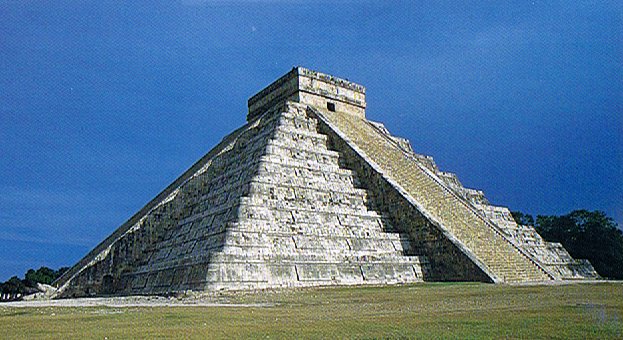
had migrated due to the precession.
Compared to the age of the Golden Calf this migration corresponded to
64 right ascension days earlier in the year as recorded by
the stars ('stones').
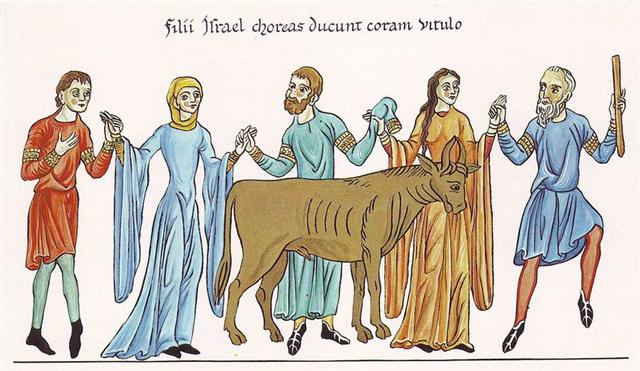
In addition the view
of orientation had changed with an
additional 16 right ascension days because it nowadays was
the true heliacal dates which determined the days and not the
return to visibility of the ruling stars late at night. 354
+ 16 = 2 * 185 = 370 → ˝ *
(392 + 348 = number of glyphs on the C
tablet).
64
(Precession) + 16 (Stars →
Sun) = 80
→ March 21 (Gregorian
equinox → 0h).
The beginning of line Bb11 had evídently been determined to coincide with September 21, i.e.
with the place 6 months after
March 21. This could be perceived as day 1 of summer south of the
equator, for here the Sun rose together with Algenib
Pegasi at the time when the Full Moon (ideally) was at Alchita
(the Raven):
... Ecclesiastically, the equinox is
reckoned to be on 21 March (even though the equinox occurs,
astronomically speaking, on 20 March [*364] in most years)
...

 |
 |
 |
 |
 |
 |
|
Bb10-42 |
Bb11-1 |
Bb11-2 (420) |
Bb11-3 |
Bb11-4 |
Bb11-5 |
|
HELIACAL STARS: |
|
Uttara Bhādrapadā-27 (2nd of the
Blessed Feet) /
Wall-14 (Porcupine)
ο Oct. (1.3),
ALGENIB PEGASI = γ Pegasi
(1.8) |
χ Pegasi (2.1), θ Andromedae (2.7) |
σ Andromedae (3.0), ι Ceti (3.3), ζ Tucanae (3.5), ρ
Andromedae, π Tucanae (3.7) |
No star listed (4) |
ANKAA
= α
Phoenicis,
κ
Phoenicis (5.0)
ALPHARD (α Hydrae) |
λ Phoenicis (6.3),
β Tucanae (6.4)
*6.4 -
*41.4 = *147.0 - 182.0 =
- *35.0 |
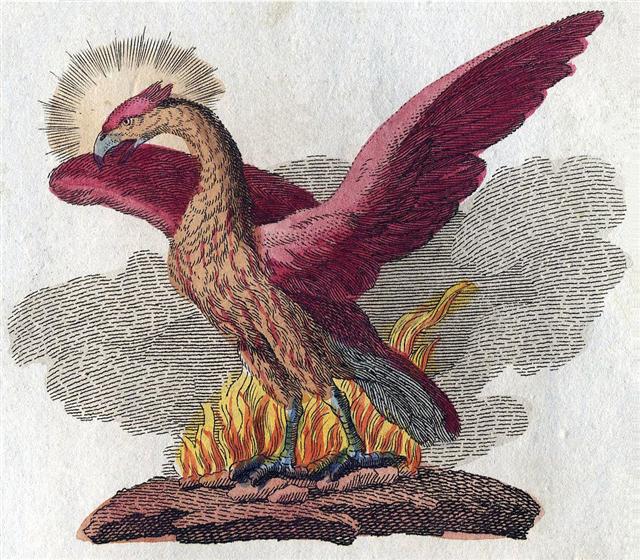
... Above the Toucan the
astronomer's bird (Grus) stretched his long neck high
with the bird on fire (Phoenix) in front, from where
the Eridanus River originated - which was at the opposite
side of the sky compared to where the Hydra ended at the
black bird Corvus ... |
|
Sept 20 |
21 (264) |
Equinox |
23 |
24 |
25 |
| JULY 18 |
19 (200) |
20 |
21 |
22 (→ π) |
23 |
|
RIGHT ASCENSION DAYS AT THE FULL MOON: |
|
ALCHITA
=
α
Corvi, MA WEI (Tail of the Horse) =
δ
Centauri
(183.1),
MINKAR =
ε
Corvi
(183.7),
ρ
Centauri (183.9) |
PÁLIDA (Pale) =
δ
Crucis
(184.6),
MEGREZ (Root of the Tail) =
δ
Ursae Majoris
(184.9) |
Hasta-13 (Hand)
/
Chariot-28 (Worm)
GIENAH
(Wing) = γ Corvi
(185.1),
ε Muscae (185.2),
ζ Crucis
(185.4), ZANIAH (Corner) = η Virginis
(185.9)
*144.0 = *185.4 - *41.4 |
CHANG SHA (Long Sand-bank) =
ζ
Corvi
(186.3) |
INTROMETIDA (Inserted) =
ε
Crucis (187.4),
ACRUX =
α
Crucis
(187.5)
*146.0 = *187.4 - *41.4 |
γ Com. Berenicis (188.0), σ Centauri (188.1),
ALGORAB = δ Corvi
(188.5),
GACRUX = γ Crucis
(188.7) |
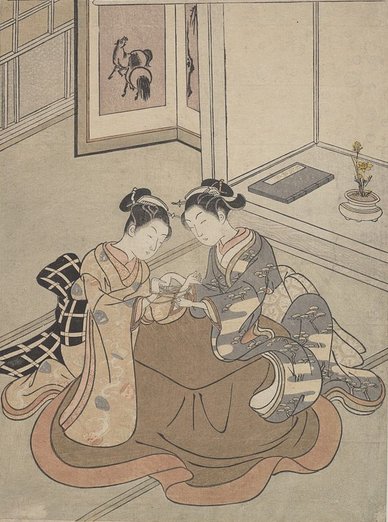
The star named Tail of the Horse was
at the Full Moon when the Sun was at Algenib, the
last of the 4 corner stars in the waterfilled Pegasus Square. |
| mai
tae e hakaruoi |
Kua
huki |
ko
te ariki |
tere
ki te vai |
e
tagata moe ra ki te huaga e |
kua
tuu ko te toga |
|
Huki. 1. Pole attached to the poop from which the
fishing-net is suspended: huki kupega. 2. Digging
stick. 3. To set vertically, to stand (vt.).
4. Huki á te mahina, said of the new moon when both
its horns have become visible. Vanaga. 1. To post up, to
publish. 2. To cut the throat (uki). Mq.: Small
sticks which close up the ridge of a house. Ha.: hui,
the small uniting sticks in a thatched house. Churchill.
Standing upright. Barthel.M. Spit for roasting. Te Huki,
a constellation. Makemson. Hukihuki. 1. Colic. 2. To
transpierce, a pricking. 3. To sink to the bottom.
Churchill. |
264
(September 21) - 64 (effects of the precession) = 200. And 200 - 16
= 184 (July 3, *104,
Adara) → Ipu Ngutu.
Gutu. 1. Lips, mouth, beak, snout (goutu); gutu ahu,
swollen lip; gutu hiti, thick lip; gutu mokomoko,
pointed lip; gutu no, vain words; gutu pakapaka,
scabbed lips; gutu raro, lower lip; gutu ruga, upper
lip. Gutugutu, snout. P Pau.: gutu, lip, beak, bill.
Mgv.: gutu, the chin, the mouth of a fish. Mq.: nutu,
beak, snout. Ta.: utu, lip, mouth, beak, snout. Gutupiri,
attentively. Gututae, attentively; gututae mekenu, a
small mouth. Gututika, tattoing on the lips. 2. Pau.:
Gutuafare, to save, to economize. Ta.: utuafare, family,
residence. 3. Pau.: Guturoa, to grimace, to pout. Mgv.:
guturoa, to grimace. Churchill.
|
282 → 164 + 118 |
Oct 9 |
SPICA |
|
|
264 |
Sept 21 |
PÁLIDA |
|
|
200 |
July 19 |
*120 |
|
|
184 |
July 3 |
ADARA |
ipu
ngutu (*104) |
|
164 |
June 13 |
PHAKT |
ngaatu (*84) |
AUGUST 4 (216) = October 7 (280) - 64:
 |
 |
 |
 |
|
Bb11-16 |
Bb11-17 |
Bb11-18 (436) |
Bb11-19 |
|
Oct 6 |
7 (280 = *200) |
8 |
9 (99 + 183 =
282) |
|
AUG 3 |
4 (216 = *136) |
5 |
6 |
|
... It was 4 August 1968, and it was the
feast day of Saint Dominic, patron of Santo Domingo Pueblo,
southwest of Santa Fe. At one end of the hot, dusty plaza, a
Dominican priest watched nervously as several hundred
dancers arranged in two long rows pounded the earth with
their moccasined feet as a mighty, collective prayer for
rain, accompanied by the powerful baritone singing of a
chorus and the beat of drums. As my family and I viewed
this, the largest and in some ways the most impressive
Native American public ceremony, a tiny cloud over the Jémez
Mountains to the northwest got larger and larger, eventually
filling up the sky; at last the storm broke, and the sky was
crisscrossed
by lightning and the pueblo resounded with peals of rolling
thunder ...

|
|
FEBR 2 |
3 |
4 (400 = *320) |
5 |
|
April 6 |
7 |
8 |
9 (99 = *19) |
|
AL DAFĪRAH (Tuft) =
β
Com. Ber.
(199.4)
*158.0 = *199.4 - *41.4 |
σ
Virginis (200.4)
*159.0 = *200.4 - *41.4 |
γ
Hydrae (201.0),
ι
Centauri (201.4)
*160.0 = *201.4 - *41.4 |
Al Simāk-12 (Lofty)
/
Chitra-14 (Bright One)
/
Horn-1 (Crocodile)
/
Sa-Sha-Shirū-19
(Virgin's Girdle)
/
ANA-ROTO-3 (Middle
pillar)
MIZAR =
ζ
Ursae Majoris (202.4),
SPICA = α Virginis,
ALCOR
(The Fox) = 80 Ursae Majoris
(202.7)
SADALMELIK (α
Aquarii)
|
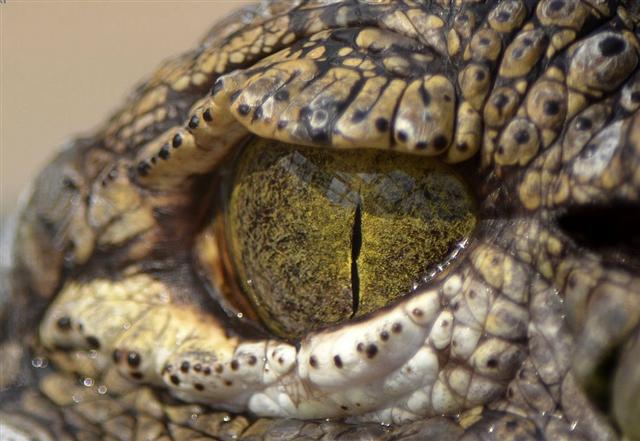 |
|
Al Batn Al Hūt-26 (Belly of
the Fish) /
Revati-28 (Prosperous)
/
1-iku (Field Measure)
MIRACH (Girdle) =
β
Andromedae,
KEUN MAN MUN (Camp's South Gate) =
φ
Andromedae
(16.0),
ANUNITUM =
τ
Piscium
(16.5),
REVATI (Abundant) =
ζ
Piscium
(16.9)
REGULUS
(α Leonis) |
ν
Phoenicis (17.4),
κ Tucanae (17.6)
*159.0 + *182.0 = 341.0 |
No star listed (18) |
ADHIL
(Garment's Train) = ξ Andromedae
(19.3),
θ
Ceti (19.7) |

... Though
Andromeda has its roots most firmly in the Greek
tradition, a female figure in Andromeda's place
appeared in Babylonian astronomy. The stars that
make up Pisces and the middle portion of modern
Andromeda formed a
constellation representing a fertility goddess,
sometimes named as Anunitum or the Lady of
the Heavens ... |
|
e tagata oho era - ki to kava e |
ka oho te Rei |
Tagata itiiti - ma to kava |
kua moe te goe |
|
Oho.
1. To go: ka-oho! go! go away!
(i.e. 'goodbye' said by the person staying behind);
ka-oho-mai (very often contracted to:
koho-mai), welcome! (lit.: come here);
ku-oho-á te tagata, the man has gone. Ohoga,
travel, direction of a journey; ohoga-mai,
return. 2. Also rauoho, hair. Vanaga. 1. To
delegate; rava oho, to root. 2. To go, to
keep on going, to walk, to depart, to retire; ka
oho, begone, good-bye; oho amua, to
preced; oho mai, to come, to bring; oho
arurua, to sail as consorts; hakaoho, to
send, a messenger. 3. Tehe oho te ikapotu, to
abut, adjoin; mei nei tehe i oho mai ai inei te
ikapotu, as far as, to; kai oho, to
abstain, to forego; hakaoho, to put on the
brakes. 4. The head (only in the composite rauoho,
hair). Churchill.
Rei.
1. To tread, to trample on: rei kiraro
ki te va'e. 2. (Used figuratively) away with
you! ka-rei kiraro koe, e mageo ę, go away,
you disgusting man. 3. To shed tears: he rei i te
mata vai. 4. Crescent-shaped breast ornament,
necklace; reimiro, wooden, crescent-shaped
breast ornament; rei matapuku, necklace made
of coral or of mother-of-pearl; rei pipipipi,
necklace made of shells; rei pureva, necklace
made of stones. 5. Clavicle. Îka reirei,
vanquished enemy, who is kicked (rei).
Vanaga. T. 1. Neck. 2. Figure-head.
Rei mua =
Figure-head in the bow.
Rei muri = Figure-head in the stern.
Henry. Mother of pearl;
rei kauaha,
fin. Mgv.: rei,
whale's tooth. Mq.:
éi, id. This is probably associable with
the general Polynesian
rei, which
means the tooth of the cachalot, an object held in
such esteem that in Viti one tooth (tambua)
was the ransom of a man's life, the ransom of a soul
on the spirit path that led through the perils of Na
Kauvandra to the last abode in Mbulotu. The word is
undoubtedly descriptive, generic as to some
character which Polynesian perception sees shared by
whale ivory and nacre.
Rei kauaha
is not this rei;
in the Maori
whakarei designates the carved work at
bow and stern of the canoe and Tahiti has the same
use but without particularizing the carving:
assuming a sense descriptive of something which
projects in a relatively thin and flat form from the
main body, and this describes these canoe ornaments,
it will be seen that it might be applied to the fins
of fishes, which in these waters are frequently
ornamental in hue and shape. The latter sense is
confined to the Tongafiti migration. Reirei,
to trample down, to knead, to pound. Pau.:
Rei-hopehopega, nape. Churchill.
Moe.
To sleep, to lie at full length, to
dream, to brood, to place, to cohabit; moe atu,
to leave off, to desist; moe atu ra, to
adjourn, to postpone; moe hakahepo, to talk
in the deep; moe aherepo, somnambulist,
sleepwalker; moe hakataha, to sleep on
the side; moe no, to oversleep, concubinage;
moe tahae, to be a light sleeper; moe
tahaga, a sleeper; moe vaeahatu,
moe hakaroa, to sleep sprawling; rava moe,
to sleep sound; ariga moe ki raro, to
lie flat on the ground; tae moe, bachelor;
hakamoe, to brood, to fold the wings; to
reserve, to lay up; to struggle. P Pau.: moe,
sleep. Mgv.: moe, sleep, to lie down, coitus,
to shut the eyes. Mq.: moe, to sleep, to lie
down; haámoe, to set down on the ground. Ta.:
moe, to sleep, to lie down. Moea raruga,
lying flat. Moeaivi, thin. Mq.: ivi,
haáivi, id. Ta.: ivi, id. Moega,
mat. Pau.: moehega, bed. Mgv.: moega,
a sleeping mat. Mq.: moena, moeka,
mat, floor cloth, bed. Ta.: moea, bed.
Moemata, to sleep with the eyes open; mea
moemata, phantom. Moemoea, a dream,
vision; tikeahaga moemoea, apparition
by night. T Mgv., Mq., Ta.: moemoea, dream.
Churchill. Mgv. Moemoe, to steal, to purloin
at a food distribution. Mq.: moemoe, to
seize, to grasp. Churchill. Ta.: 1. Moemoe,
ambush. Ha.: moemoe, id. 2. Moemoe,
Phyllanthus simplex. To.: mohemohe, a tree.
Churchill. Mq.: Moehu, exiled, banished,
prisoner of war. Ma.: morehu, a survivor.
Churchill.
Goe. Milky Way. Vanaga. |
In the Chinese overview we can see how the pattern of the 7 stars in the
Corvus constellation - located
partly in the tail of the Red Bird - has been drawn
similar
to the outline of the 5 main stars (including Dramasa) of the Southern Cross.
Here one of its stars (ι)
-
close to Mimosa (β) -
evidently could correspond to the Wing of Raven (γ,
Gienah, *185):
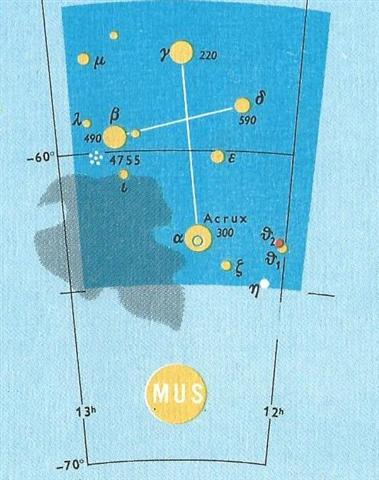
Then the Blue Dragon
would rise, beginning with Spica and Heze.
Dragons can fly → move up
towards the north pole circled by the Draco constellation.

It seems reasonable to assume the Crocodile (Spica)
would evolve into a
Dragon
(κ Virginis) precisely because
that was the direction indicated by the beginning of the
quarter following summer.
... At Mangaia the spirits of those who
ignobly died 'on a pillow' wandered about disconsolately
over the rocks near the margin of the sea until the day
appointed by their leader comes (once a year). Many months
might elapse ere the projected departures of the ghost took
place. This weary interval was spent in dances and
revisiting their former homes, where the living dwell
affectionately remembered by the dead. At night fall they
would wander amongst the trees and plantations nearest to
these dwellings, sometimes venturing to peep inside. As a
rule these ghosts were well disposed towards their own
living relatives; but often became vindictive if a pet child
was ill-treated by a stepmother or other relatives etc ...
Eventually the spirits would depart from known reinga,
spirit leaping-places. Such leaping-places also existed on
other islands. Even after this departure some spirit
intrusions from the underworld were possible ...
... Far away, the Mangaians of old
(Austral Islands, Polynesia), who kept the precessional
clock running instead of switching over to 'signs', claim
that only at the evening of the solstitial days can spirits
enter heaven, the inhabitants of the northern parts of the
island at one solstice, the dwellers in the south at the
other ...
 |
 |
 |
 |
|
Bb11-18 (436) |
Bb11-19 |
Bb11-20 |
Bb11-21 |
|
Oct 8
(281 = *201) |
9 (100 +
182) |
10 (100 +
183) |
11 (100 + 184) |
|
AUG 4 (217 = *137) |
5 |
6 |
7 (220) |
|
FEBR 4 (400 = *320) |
5 |
6 |
7 (*324) |
|
April 8 |
9 (99 =
*19) |
10 |
11 (101) |
|
DHANAB AL SHUJA (Tail
of the Water Serpent) = γ Hydrae
(201.0),
ι
Centauri (201.4)
*160.0 = *201.4 - *41.4 |
Al Simāk-12 (Lofty)
/
Chitra-14
(Bright One) /
Horn-1
(Crocodile) /
Sa-Sha-Shirū-19
(Virgin's Girdle)
/
ANA-ROTO-3
(Middle pillar)
MIZAR =
ζ
Ursae Majoris (202.4),
SPICA = α Virginis,
ALCOR
(The Fox) = 80 Ursae Majoris
(202.7)
SADALMELIK (α Aquarii) |
71 VIRGINIS
(203.6) |
No star listed (204) |
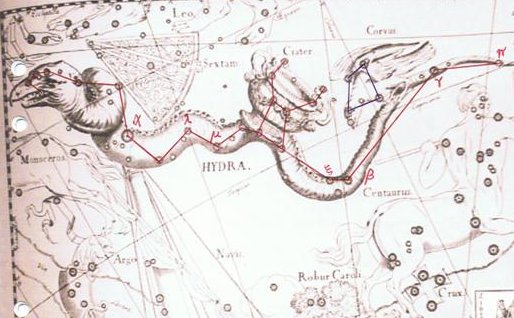 |
|
No star listed (18) |
ADHIL (Garment's Train) = ξ
Andromedae
(19.3),
θ
Ceti (19.7) |
KSORA (Knee) =
δ
Cassiopeiae
(20.1),
ω
Andromedae (20.6),
γ
Phoenicis (20.8) |
δ Phoenicis
(21.5) |
|
Tagata itiiti - ma to
kava |
kua moe te goe |
erua ra manu |
kua oho |
|
...
Then a man arose
from ocean // From the waves a hero started,
// Not the hugest of the hugest, // Not the
smallest of the smallest. // As a man's
thumb was his stature; //
Lofty as the span of
woman ...
→ tagata
itiiti.
...
Though Andromeda has its roots most firmly
in the Greek tradition, a female figure in
Andromeda's place appeared in Babylonian
astronomy. The stars that make up Pisces and
the middle portion of modern Andromeda
formed a constellation
representing a fertility goddess, sometimes
named as Anunitum or the Lady of the
Heavens ...
Goe. Milky Way.
Vanaga.
... In
several variants the oak is said to have
fallen over the Northland River, so as to
form the bridge into the abode of the dead.
Holmberg (quoted by Lauri Honko, 'Finnen',
Wb. Myth., p. 369) took the oak for
the Milky Way ...
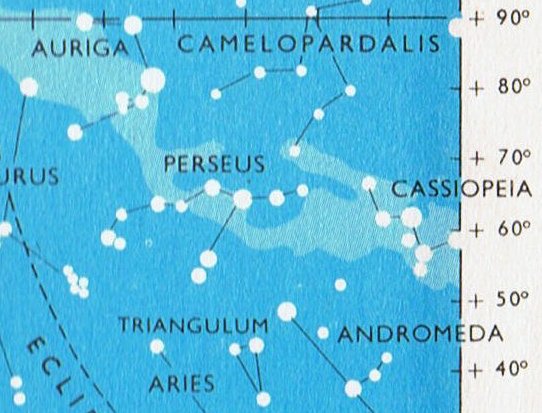 |
According to the Mayan view the
beginning of the Blue Dragon (at its tail) - the
Crocodile or rather the Cayman
(Keyemen) - seems to have been put in
opposition to the beginning of the Grey Tiger (at its
tail = the
northern spring equinox).
...
Men and birds joined forces to destroy the huge watersnake,
which dragged all living creatures down to his lair. But the
attackers took fright and cried off, one after the other,
offering as their excuse that they could only fight on dry
land. Finally, the duckler (K.G.: a diver) was brave enough
to dive into the water; he inflicted a fatal wound on the
monster which was at the bottom, coiled round the roots of
an enormous tree. Uttering terrible cries, the men succeeded
in bringing the snake out of the water, where they killed it
and removed its skin. The duckler claimed the skin as the
price of its victory. The Indian chiefs said ironically, 'By
all means! Just take it away!' 'With pleasure', replied the
duckler as it signalled to the other birds. Together they
swooped down and, each one taking a piece of the skin in its
beak, flew off with it. The Indians were annoyed and angry
and, from then on, became the enemies of birds. The birds
retired to a quiet spot in order to share the skin. They
agreed that each one should keep the part that was in its
own beak. The skin was made up of marvelous colors - red,
yellow, green, black, and white - and had markings such as
no one had ever seen before. As soon as each bird was
provided with the part to which it was entitled, the miracle
happened: until that time all birds had had dingy plumage,
but now suddenly they became white, yellow, and blue ... The
parrots were covered
in green and red, and the macaws
with red, purple, and gilded feathers, such as had never
before been seen. The duckler, to which all the credit was
due, was left with the head, which was black. But it said it
was good enough for an old bird ...
The white egret took its piece [of the
skin of 'Keyemen - the rainbow in the shape of a huge
watersnake'] and sang, 'ā-ā', a call that it still has to
this day. The maguari (Circonia maguari, a stork) did
likewise and uttered its ugly cry: 'a(o)-a(o)'. The soco (Ardea
brasiliensis, a heron) placed its piece on its head and
wings (where the colored feathers are) and sang,
'koro-koro-koro'. The kingfisher (Alcedo species) put
its piece on its head and breast, where the feathers turned
red, and sang, 'se-txe-txe-txe' ...
For Itzam-Yeh
(Ursa Major) → the Smith (Tagata itiiti)
→ Samson (the Hairy Man who
would fell the Old Oak with his enchanted
Jawbone) -

... A Maori saying: he iti toki, e rite ana ki te tangata
= though the adze be small, yet does it equal a man ...
had once
upon a time been at the beginning of the year, but due to the
precession (and 16 added days) his position was nowadays at
the northern spring equinox:
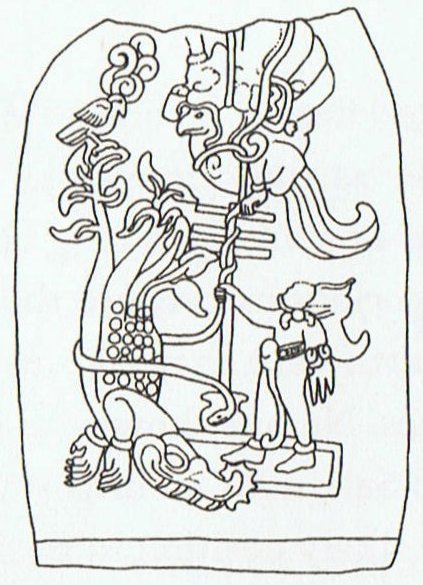
|





















